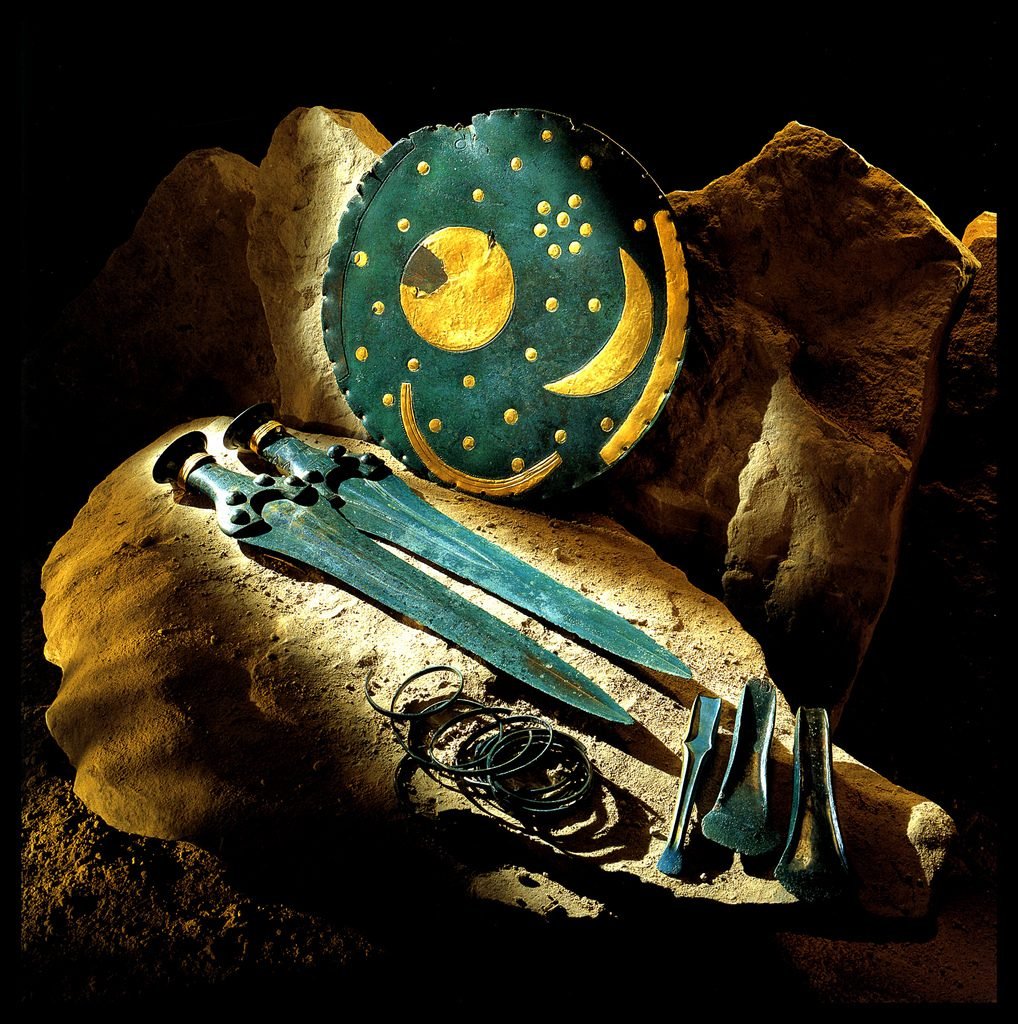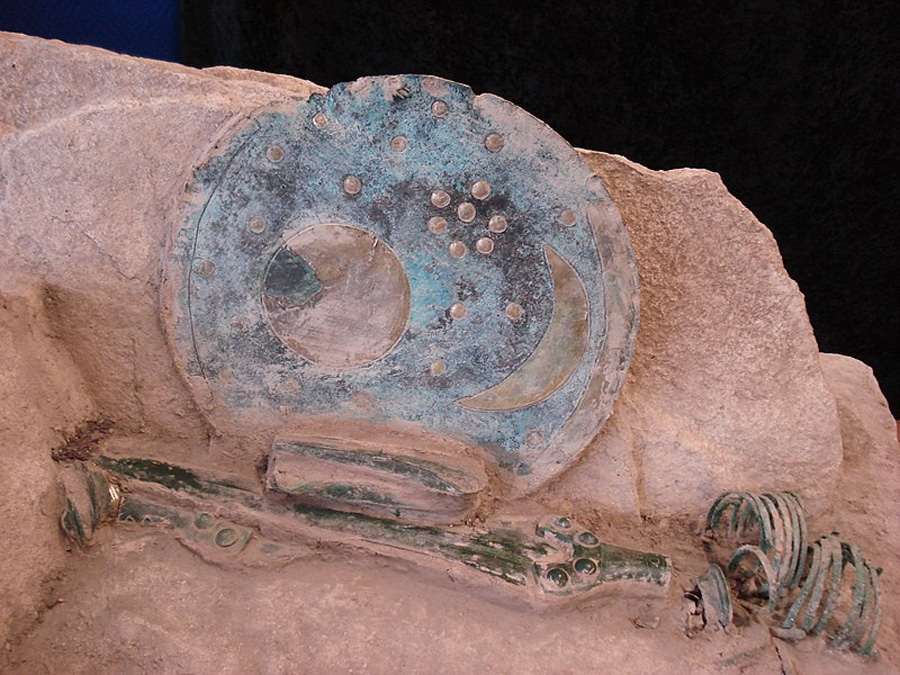The design on this disc might look like a six-year-old’s scribbles, but in reality, it’s one of the most sophisticated and influential artifacts of the Bronze Age.And it might never have been discovered if not for a couple of illegal treasure hunters who dug it up and sold it on the black market.
Called the Nebra sky disc, named for the town where it was found in 1999, the artifact has been dated back to 1600 BC. It’s thought to have been forged during the European Bronze Age, a period between 3200 and 600 BC.
The disc’s discovery stunned archaeologists, who thought of the Bronze Age as brutal, uncivilized times of killing and little else — most artifacts we’ve found are swords and other weapons designed for battle.
The disc is about one foot across and weighs nearly five pounds. When it was first crafted, it would have shone a brilliant golden brown because the disc itself is made from bronze. But over time, the bronze corroded to green.

The symbols are made of gold and didn’t corrode. Although experts do not agree on what each symbol represents, for example the full circle could be the sun, full moon, or some type of eclipse, the overall message is clear that the symbols represent celestial objects.
This disc meant that the people of the Bronze Age were not an uncivilized culture that only crafted weapons for killing. Instead, the people who lived at this time had an intellectual understanding of the sky.
Police-Led Sting For The Find Of The Century
For millennia, the disc was buried in the Seigelroda Forest in the German state of Saxony-Anhalt near a town called Nebra. But in 1999, two men, Henry Westphal and Mario Renner, were hunting for buried treasure in the forest when their metal detectors led them to an underground stash. They uncovered two bronze swords, two hatchets, a chisel, fragments of bracelets, and the beautifully decorated disc.
According to state law in Saxony-Anhalt, all archaeological artifacts are the property of the state. Westphal and Renner had no license to dig for artifacts of any kind, and no legal right to the collection. But that didn’t stop them from selling everything they found on the black market.
Over the next few years the entire collection became a well-known commodity and was traded multiple times on the black market selling for up to one million Deutsch Mark (roughly $590,000). Then, in 2002, archaeologist Herald Meller arranged a meeting with the current holders to purchase the disc, alone, for 700,000 DM ($350,000). But the meeting was not what it seemed.
Meller was collaborating with the state police to recover the priceless artifacts, and within seconds of the dealers’ reveal of the disc, the police swooped in and arrested them. Eventually, the disc was traced back to Westphal and Renner who were sentenced to jail time.
Spotting A Fake
Archeologist’s were stunned when they finally got a good, close look at the artifact. The Nebra sky disc was unlike any other artifact of its time. Some archaeologists thought the disc was too incredible to be real.
“When I first heard about the Nebra Disc I thought it was a joke, indeed I thought it was a forgery,” Richard Harrison told the BBC in a documentary of the disc. Harrison is a professor of European prehistory at the University of Bristol and expert on the culture that inhabited Germany during the Bronze Age. “Because it’s such an extraordinary piece that it wouldn’t surprise any of us that a clever forger had cooked this up in a backroom and sold it for a lot of money.”
The disc was sent to the laboratory of Heinrich Wunderlich at the Museum of Halle in Eastern Germany. Heinrich specializes in dating artifacts from the Bronze age. If the disc was a fake, he could easily find out by studying the greenish bronze covering the disc.
Bronze disease is the corrosive process that occurs when chloride molecules, such as chloride salts in soil, interact with bronze (or other copper-based materials). The result is a chemical reaction producing microscopic crystals that look either white or green. Over time, these crystals grow larger, which means that Wunderlich could easily spot a forgery by looking at the size of the crystals.
When he looked under the microscope, he saw large crystals, which resembled large bubbles, shown in the image below, that spoke to the disc’s authenticity. It was no fake.
“When I saw down the microscope, I saw structure which was like bubbles,” Wunderlich told BBC. “This can not be made artificially. You can’t fake time.”
Secrets Of The Nebra Sky disc
Scientists have dated the disc to the time it was buried underground, but they don’t know exactly when it was made. It was buried about 3,600 years ago but could be much older.
In addition to its age, the precise meaning of the disc eludes explanation. But an expert in Bronze Age religions, Miranda Aldhouse Green, at Cardiff University in the UK, has put together a general picture of what it might have meant for the people who used it thousands of years ago.
Below is a labeled version of the disc, but you’ll have to translate some of the words since they’re in German.
Gerhard Singer on Flickr
It makes sense that the full circle slightly left of center would be the sun, Green said in the BBC documentary, “The sun is absolutely central to northern European Bronze Age religion. There’s a clear connection between the sun and life. If the sun disappears then life comes to an end.”
And the crescent shape is likely a crescent moon. In ancient times, the moon was used to represent time, and, “if you can control time, and if you understand time, then you are a powerful, a powerful human being,” Green said.

Then there’s the smiley-shaped band beneath the sun and moon, which Green suspects is the sun boat — an ancient holy symbol. Bronze Age Europeans believed that the sun traveled on a sun boat when it set at night.
The smaller circles speckled across the disc seem to represent stars. In particular, the concentrated clump between the sun and moon are thought to be the Pleiades constellation, which was an imporant constellation for Bronze Age farmers because it first appeared in March and disappeared in October — important farming times.

“We know from Greek writers that the Pleiades were used as an agricultural marker, so that farmers knew when they should do certain agricultural activities,” Green said. “So what the Nebra disc does is to tell people not only the right time to [plant and harvest] but it is the blessed time to do it.”
The left and right arcs on either side of the disc have an additional agricultural importance and were crucial in helping scientists determine that the disc was European-made.
It was astronomer Wolfhard Schlosser, at the University of Hamburg, who made the connection. He found that if you draw a line from the center of the disc to the top and bottom end of the right arc, the angle between the two ends measures exactly 82 degrees. And it’s the same value for the left golden arc.
This number is very important for only a small group of people who live at the same latitude as the current German town of Nebra. That’s because it’s the angle between where the sun sets on the horizon in mid-winter and mid-summer.
“The angle between both is precisely eighty two degrees,” Schlosser told BBC. “This angle responds to the journey of the sun between summer and winter for this specific latitude right here in Nebra.”
Although Schlosser’s find offered compelling evidence that the disc was crafted in Europe, the only way to determine beyond any doubt was to discover where the metals came from.
Archaeologist Ernst Pernicka further investigated the copper within the bronze. Copper has a unique fingerprint that Pernicka used to compare copper in Bronze Age mines versus Mediterranean metals. From this, he traced the disc’s metal to a European mine, confirming that the disc was manufactured from European metal and was not a gift crafted by another culture.
After millennia under ground and years on the black market, the disc today is safe and on public display at the State Museum of Prehistory in Halle, Germany.
In 2013, the United Nations Educational, Scientific and Cultural Organization inducted the disc into their Memory of the World Register stating:
The bronze disc is considered to be one of the most important archaeological finds of the 20th Century. It combines an extraordinary comprehension of astronomical phenomena with the religious beliefs of its period, that enable unique glimpses into the early knowledge of the heavens.